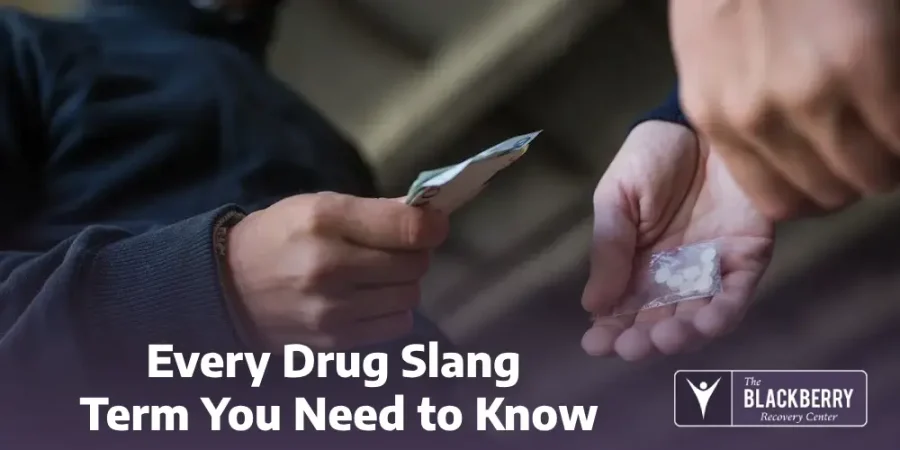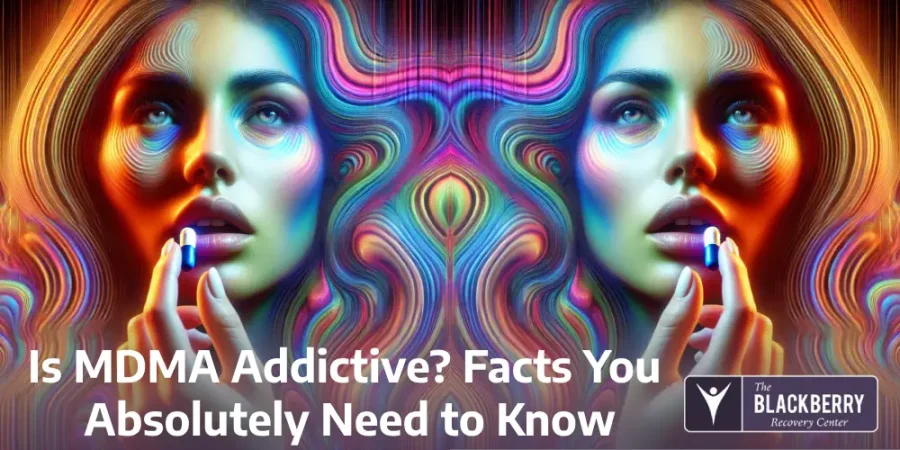If you suspect that your loved one is abusing drugs, then you might notice them using new, unfamiliar drug slang. Unfortunately, using popular slang for drugs is a common sign of addiction. Your loved one’s new verbiage may make you feel nervous or uneasy, and it can be hard for non-drug-users to recognize “common” slang terms. If this sounds familiar, then this article is for you.
Today we’re going to discuss common drug slang terms for everything from club drugs to prescription drugs.
Ecstasy

Ecstasy
Ecstasy is perhaps one of the best-known party drugs. Also called MDMA and Molly, this synthetic drug creates a high where the user feels more relaxed and trusting. For that reason, it’s a popular party drug for rave-goers. Some of the most common terms for ecstasy include:
- Adam
- Candy
- Dancing Shoes
- E
- E-bombs
- Hug Drug
- Love Drug
- Malcolm
- Scooby Snacks
- Smarties
- Skittles
- Vitamin E
- X
- XTC
Opioids
Opioids are some of the most commonly abused prescription drugs in the world. Opioid addiction is a nationwide epidemic, and widespread opioid abuse has led to a variety of unconventional drug slang terms for this prescription medication. Different types of opioids have different terms, but some of the most common include:
- Codeine Brands Combined with Aspirin: Lean, Captain Cody, Cody, Schoolboy and Sizzurp.
- Oxycodone Brands: Oxycet, Percs, O, Hillbilly Heroin, Blue, O.C., Kickers, and Killers.
- Fentanyl: Apache, China Girl, China White, Jackpot, Murder 8, and Friend.
- Hydrocodone: Vics, Vicos, Hydros, Scratach, Norco, and Tabs.
- Heroin: Black Tar, H, Mud, Dragon, Skunk, Thunder, Big H, Smack, and Dope.
- Morphine Brands: Monkey, M, Miss Emma, and White Stuff.
Amphetamines
Amphetamines include drugs like Adderall, Ritalin, and other stimulants. Commonly prescribed to treat ADHD, these medications often give users a boost of energy. For that reason, they’re popular among professionals who use these drugs to accomplish more tasks in a day. Below you’ll find the most common slang for amphetamines:
[gdlr_core_row][gdlr_core_column size=”1/3″]- Addy
- Amp
- Beans
- Cartwheels
- Chalk
- Christina
- Diamonds [/gdlr_core_column] [gdlr_core_column size=”1/3″]
- Dolls
- Dominoes
- Footballs
- Hearts
- Jelly Beans
- Little Bombs
- Morning Shot [/gdlr_core_column][gdlr_core_column size=”1/3″]
- Peaches
- Pep Pills
- Rippers
- Roses
- Turnabouts
- Zoomers [/gdlr_core_column][/gdlr_core_row]
Methamphetamine

Where amphetamines are generally low dosages of stimulants, methamphetamine goes well beyond what most doctors are willing to prescribe. Generally created in meth labs by combining harmful chemicals with cold medicines, this illicit substance is known to give users a lot of energy and lead them to act in manic, unpredictable ways. For this drug, slang terms include:
- Chalk
- Cookies
- Crank
- Christina
- Dunk
- Gak
- Pookie
- Rocket Fuel
- Wash
- White Cross
Cocaine
Cocaine use died down amidst regulations in the early 1900s, but saw a resurgence in the 1980s. This was partially due to the development of a new form of cocaine: crack cocaine. This drug is cocaine mixed with water and another agent, often baking powder. And when it first appeared, it was cheap, readily available, and easy to acquire. Now, many Americans still take cocaine and crack cocaine regularly because it’s cheap and easy to come by. If you suspect that your loved one is suffering from an addiction to crack cocaine, then watch out for these common terms:
- For Cocaine: Coke, Blow, Rail, Line, Snow, Bump, Powder, Stash, and Big C.
- For Crack Cocaine: Candy or Rock Candy, Rocks, Ball, Base, Hail, Dice, Grit, Chemical, and Tornado.
Slang for Drug Combinations
Oftentimes, people abusing drugs do not take one substance by itself. Instead, they combine various drugs together to create specific highs. Unfortunately, this practice is dangerous and may cause overdoses and related medical issues.
[gdlr_core_row][gdlr_core_column size=”1/3″]- Atom Bombs: Marijuana mixed with heroin.
- Bars: Heroin mixed with Xanax.
- Bazooka: Crack cocaine combined with unrefined cocaine and/or marijuana.
- Bumping Up: Ecstasy combined with powder cocaine.
- Caviar: Taking cocaine and marijuana very closely together.
- Dynamite: Cocaine mixed with heroin.
- Eightball: Crack cocaine combined with heroin. [/gdlr_core_column] [gdlr_core_column size=”1/3″]
- Gimme: A mixture of crack and marijuana.
- Greek: Marijuana and powder cocaine.
- Handlebars: Crack cocaine combined with Xanax.
- Hugs and Kisses: Combination of methamphetamine and cocaine.
- Jet Fuel: PCP combined with methamphetamine.
- Lace: Cocaine and marijuana.
- Moon Rock: Crack cocaine and heroin.
- Nox: Nitrous oxide and MDMA [/gdlr_core_column][gdlr_core_column size=”1/3″]
- Ozone: A marijuana, PCP, and crack cocaine cigarette.
- Pharming: Mixing prescription drugs.
- Primos: Marijuana cigarettes treated with crack cocaine.
- Screwball: Heroin and methamphetamine.
- Smoking Gun: Heroin and cocaine.
- Tar: Crack and heroin.
- Waffle Dust: Ecstasy and methamphetamine. [/gdlr_core_column][/gdlr_core_row]
Is Your Loved One Using Drugs?
If you’ve noticed that your friend or family member acts strangely and uses any of the language above, there is a real chance that they are suffering from drug addiction. That means that now is the best time to discuss addiction treatment options with them. Remember, drug addiction can feel impossible to overcome, so they need your support now more than ever.
Do you have questions about how your loved one can get help? Call our admissions staff at (813) 908-4199 and they’ll be happy to answer your questions. Or, if you’d rather we get in touch with you, fill out our confidential contact form and a member of our team will get back to you shortly. No matter how you ask for help, we’ll be ready to help you and your loved one.
Video
Talking about DRUGS in English – Slangs
Podcast
Role Models & Drug Slang






